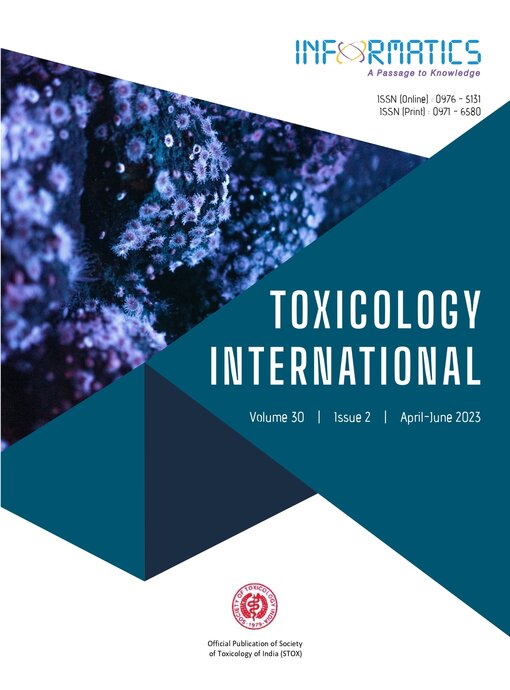Effect of Fenvalerate Toxicity on Biochemical and Haematological Parameters and Ameliorative Effect of Quinoa Seeds in Swiss Albino Mice
DOI:
https://doi.org/10.18311/ti/2023/v30i2/31835Keywords:
Biochemical, Blood, Fenvalerate, Mice, Quinoa SeedsAbstract
Fenvalerate is a synthetic pyrethroid insecticide with moderate mammalian toxicity. It affects the central nervous system and is used for the control of flies and ticks in barns and stables. Exposure of this insecticide to humans occurs in the field. The present study was conducted to observe the toxicity of insecticide on biochemical and blood parameters after treatment with fenvalerate, a synthetic pyrethroid and find out the possible protective role of Quinoa seeds in Swiss albino mice. The mice in this study were divided into 5 groups, and 6 animals were taken into each group. Group A control mice received vehicle distilled water only. Group B and C were administered with fenvalerate at 12.5 and 25 mg/kg body weight respectively for 30 days. Group D was administered 12.5 mg/kg fenvalerate +25 mg/kg Quinoa seeds and Group E received 25 mg/kg fenvalerate +50 mg/kg Quinoa seeds. Fenvalerate treatment resulted in a significant increase in the levels of alkaline phosphatase, acid phosphatase, Serum Glutamate Pyruvate Transaminase (SGPT) and Serum Glutamate Oxaloacetate Transaminase (SGOT). Administration of Quinoa seeds along with fenvalerate resulted in a decrease in these biochemical values. A significant increase in the number of RBC, WBC and haemoglobin was observed in the fenvalerate-treated groups. The result suggests a possible protective role of Quinoa seeds on fenvalerate toxicity.
Downloads
Published
How to Cite
Issue
Section
Accepted 2023-01-31
Published 2023-05-11
References
Reigert JR, Roberts JR. Recognition and management of pesticide poisonings. 6th ed. Washington, DC: Office of Pesticide Programs United States Environmental Protection Agency. 2013; p. 38.
Silver KS, Du Y, Nomura Y, Oliveira EE, Salgado VL, Zhorov BS, Dong K. Voltage-Gated Sodium Channels as Insecticide Targets. Adv In Insect Phys. 2014; 46:389-433. https://doi.org/10.1016/B978-0-12-417010-0.00005-7 PMID: 29928068 PMCID: PMC6005695 DOI: https://doi.org/10.1016/B978-0-12-417010-0.00005-7
Sayeed I, Parvez S, Pandey S, Bin-Hafeez B, Haque R, Raisuddin S. Oxidative stress biomarkers of exposure to deltamethrin in freshwater fish, Channa punctatus Bloch. Ecotoxicology and Environmental Safety. 2003; 56(2):295- 301. https://doi.org/10.1016/S0147-6513(03)00009-5 DOI: https://doi.org/10.1016/S0147-6513(03)00009-5
Locey BJ, Reeves J. Fenvalerate. Encyclopedia of Toxicology 2nd ed. U.S.A. Academic Press. 2005; p. 328-330. https://doi. org/10.1016/B0-12-369400-0/00412-9 DOI: https://doi.org/10.1016/B0-12-369400-0/00412-9
Cage SA, Bradberry SM, Meacham S, Vale JA. Fenvalerate. Inchem Report. National Poisons Information Service. Birmingham,United Kingdoms. 1998.
Anonymous. Fenvalerate. JMPR Report. Rome, Italy: World Health Organisation. 2012; p. 153.
Caglayan A, Kocer-Gumusel B, Erkekoglu P, Hincal F. The effects of fenvalerate on hepatic and cerebral xenobiotic metabolizing enzymes in selenium and/or iodine deficient rats. Iran J Basic Med Sci. 2016; 19(10):1040-48. PMID: 27872699 PMCID: PMC5110651
Cabral JBR, Galendo D. Carcinogenicity study of the pesticide fenvalerate in mice. Cancer Letters. 1990; 49(1):13-8. https://doi.org/10.1016/0304-3835(90)90133-I DOI: https://doi.org/10.1016/0304-3835(90)90133-I
Garg U, Pal AK, Jha GJ, Jadhao SB. Haemato-biochemical and immuno-pathophysiological effects of chronic toxicity with synthetic pyrethroid, organophosphate and chlorinated pesticides in broiler chicks. International Immunopharmacology. 2004; 4(13):1709-22. https://doi. org/10.1016/j.intimp.2004.08.002 DOI: https://doi.org/10.1016/j.intimp.2004.08.002
Haratyam- Maj A. Hematological alterations after pyrethroids poisoning in mice. Annals of agricultural and environmental medicine. 2002; 9(2):199-206. Available from: http://www.aaem.pl/Hematological-alternationsafter- pyrethroids-poisoning-in-mice-,72793,0,2.html
Saxena S, Shahani L, Bhatnagar P. Hepatoprotective effect of Chenopodium quinoa seed against CCL4-induced liver toxicity in Swiss albino male mice. Asian J Pharm Clin Res. 2017; 10(11):273-6. https://doi.org/10.22159/ajpcr.2017. v10i11.20918 DOI: https://doi.org/10.22159/ajpcr.2017.v10i11.20918
Luty S, Latuszyn`ska J, Obuchowska-Przebirowska D, Tokarska M, Haratyam- Maj A. Subacute toxicity of orally applied alpha-cypermethrin in Swiss mice. Ann Agric Environ Med. 2000; 7:33-41. https://doi.org/10.1111/ an.2000.41.7.33
Karmen A, Wroblewski F, Ladue J.S. Transaminase activity in human blood. The Journal of Clinical Investigation. 1955; 34(1):126–31. https://dm5migu4zj3pb.cloudfront. net/manuscripts/103000/103055/JCI55103055.pdf https://doi.org/10.1172/JCI103055 DOI: https://doi.org/10.1172/JCI103055
Sharma U, Pal D, Prasad R. Alkaline Phosphatase: An Overview. Ind J Clin Biochem. 2014; 29(3):269-78. https://doi.org/10.1007/s12291-013-0408-y DOI: https://doi.org/10.1007/s12291-013-0408-y
Wróblewski F. The clinical significance of alterations in transaminase activities of serum and other body fluids. Advances in clinical chemistry, Elsevier. 1958; 1:313-351. https://doi.org/10.1016/S0065-2423(08)60362-5 PMID: 13571034 DOI: https://doi.org/10.1016/S0065-2423(08)60362-5
Giannini EG, Testa R, Savarino V. Liver enzyme alteration: A guide for clinicians. Cmaj. 2005; 172(3):367-79. https:// doi.org/10.1503/cmaj.1040752 17. Rej R. Aminotransferases in disease. Clin Lab Med. 1989; 9(4):667-87. https://doi.org/10.1016/S0272- 2712(18)30598-5 PMID: 2686908
Parker CM, McCullough CB, Gellatly JB, Johnston CD. Toxicologic and carcinogenic evaluation of fenvalerate in the B6C3F1 mouse. Fundamental and Applied Toxicology. 1983; 3(2):114-20. https://doi.org/10.1016/S0272- 0590(83)80066-9 DOI: https://doi.org/10.1093/toxsci/3.2.114
Hussein HK, Elnaggar MH, Al-Dailamy JM. Protective role of Vitamin C against hepatorenal toxicity of fenvalerate in male rats. Glo Adv Res J Environ Sci Toxicol. 2012; 1(4):060-5. https://www.researchgate.net/profile/Moustafa-Elnaggar/ publication/303683848_Hussein_HK_ELNAGGAR_ MHR_and_Al-Dailamy_JM_2012_Protective_role_of_ Vitamin_C_against_hepatorenal_toxicity_of_fenvalerate_ in_male_rats_Glob_Adv_Res_J_Environ_Sci_ Toxicol_14_60-65/links/5cc6e698a6fdcc1d49b7c417/ Hussein-HK-ELNAGGAR-MHR-and-Al-Dailamy-JM- 2012-Protective-role-of-Vitamin-C-against-hepatorenaltoxicity- of-fenvalerate-in-male-rats-Glob-Adv-Res- -J-Environ-Sci-Toxicol-14-60-65.pdf
Dar SA, Kaur R. Hematobiochemical evaluation of dermal subacute cypermethrin toxicity in buffalo calves. Toxicology International. 2014; 21(3):283-7. https://doi.org/10.4103/0971-6580.155364 PMID: 25948967 PMCID: PMC4413411 DOI: https://doi.org/10.4103/0971-6580.155364
Ravikumar Y, Madhuri D, Lakshman M, Reddy AG, Kalakumar B. Study of cadmium and chlorpyrifos induced changes in protein and lipid profile in rats. Toxicology International. 2020; 27(1&2):54-7. https://doi. org/10.18311/ti/2020/v27i1&2/25279
Olson H, Betton G, Robinson D, Thomas K, Monro A, Kolaja G, Lilly P, Sanders J, Sipes G, Bracken W, Dorato M. B., and Heller, A. Concordance of the toxicity of pharmaceuticals in humans and in animals. Regul Toxicol Pharmacol. 2000; 32(1):56-67. https://doi.org/10.1006/rtph.2000.1399 PMID: 11029269 DOI: https://doi.org/10.1006/rtph.2000.1399
Tos-Luty S, Haratym-Maj A, Latuszynska J, Obuchowska- Przebirowska D, Tokarska-Rodak M. Oral toxicity of deltamethrin and fenvalerate in Swiss mice. Ann Agric Environ Med. 2001; 8(2):245-54 https://agro.icm.edu.pl/agro/element/bwmeta1.element.agro-article-56243671- 30dd-4299-add2-edabf8f214e2
Masud S, Singh IJ. Effect of Cypermethrin on some hematological parameters and prediction of their recovery in a freshwater Teleost, Cyprinus carpio. Afr J Environ Sci Technol 2013; 7(9):852-6. https://doi.org/10.5897/ AJEST11.376
Sharma P, Singh R, Jan M. Dose-dependent effect of deltamethrin in testis, liver, and kidney of Wistar rats. Toxicology International. 2014; 21(2):131-9. https://doi.org/10.4103/0971-6580.139789 PMID: 25253921. PMCID: PMC4170553 DOI: https://doi.org/10.4103/0971-6580.139789
 Lata Shahani
Lata Shahani







